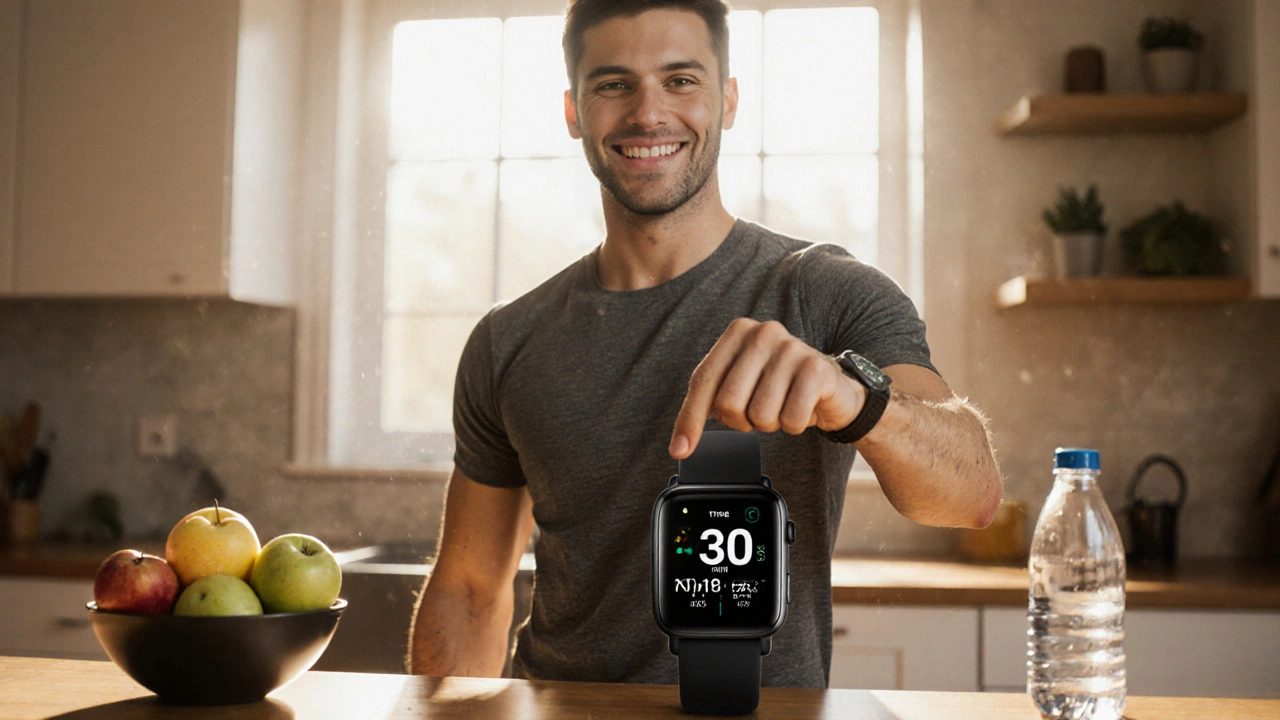Is 30 Minutes of Exercise Daily Enough for Weight Loss?
 Oct, 8 2025
Oct, 8 2025
30-Minute Exercise Calorie Burn Calculator
Estimated Calorie Burn
This represents your daily calorie deficit target for healthy weight loss.
Calorie Burn Reference Table
| Activity | Average Calories Burned (30 mins) | Intensity Level |
|---|---|---|
| Brisk walking (5 km/h) | 150 kcal | Moderate |
| Jogging (8 km/h) | 300 kcal | Vigorous |
| Stationary bike (moderate resistance) | 250 kcal | Moderate-Vigorous |
| HIIT circuit (bodyweight) | 400 kcal | Very Vigorous |
| Strength training (full-body) | 180 kcal | Moderate |
Trying to shed pounds often leads to the question: is a 30‑minute workout each day enough to lose weight? The short answer is yes-if you pair it with the right intensity, nutrition, and consistency. Below we break down how a half‑hour of activity can create a calorie deficit, what types of exercise give the biggest bang for your buck, and common pitfalls that keep the scale stuck.
Key Takeaways
- A 30‑minute session can burn 200‑500 calories depending on intensity and body weight.
- Combining cardio and strength training maximizes fat loss while preserving muscle.
- Nutrition drives the deficit; exercise alone rarely creates a large enough gap.
- Consistency and progressive overload are more important than a single workout length.
- Track your calories, adjust intensity, and listen to recovery cues for sustainable results.
Understanding the Core Principle: Calorie Deficit
Calorie deficit is the state where you consume fewer calories than your body expends, forcing it to tap stored fat for energy. Without a deficit, weight loss stalls regardless of how much you move. Typically, a safe deficit ranges from 250 to 500 calories per day, leading to a loss of about 0.5kg (1lb) per week.
How Much Can 30 Minutes Actually Burn?
Calorie burn (also called energy expenditure is the amount of calories you use during activity, measured in kilocalories (kcal)) varies by three main factors: your body weight, the activity’s intensity, and its type.
- Body weight: Heavier individuals naturally burn more calories at a given intensity. A 90kg (198lb) person may burn roughly 1.2× the calories of a 70kg (154lb) person during the same workout.
- Intensity: Vigorous effort (e.g., HIIT, fast‑paced running) can double the calorie cost compared to moderate activity (e.g., brisk walking).
- Activity type: Some movements recruit more muscle groups and elevate heart rate, boosting total burn.
Below is a quick reference based on a 70kg adult:
| Activity | Average Calories Burned | Intensity Level |
|---|---|---|
| Brisk walking (5km/h) | 150kcal | Moderate |
| Jogging (8km/h) | 300kcal | Vigorous |
| Stationary bike (moderate resistance) | 250kcal | Moderate‑Vigorous |
| HIIT circuit (bodyweight) | 400kcal | Very Vigorous |
| Strength training (full‑body) | 180kcal | Moderate |
Those numbers show that a 30‑minute high‑intensity session can easily exceed the 250‑calorie mark, contributing meaningfully to a daily deficit.

Choosing the Right Kind of 30‑Minute Workout
Not all 30‑minute workouts are created equal. Here’s how three popular formats stack up in the weight‑loss arena.
| Factor | Cardio (Steady‑State) | Strength Training | HIIT |
|---|---|---|---|
| Average Calorie Burn | 250‑300kcal | 150‑200kcal | 350‑450kcal |
| Muscle Preservation | Low | High | Moderate‑High |
| After‑burn Effect (EPOC) | Low | Moderate | High |
| Equipment Needed | Minimal | Weights or bands | Bodyweight or light gear |
| Suitability for Beginners | High | Medium (need guidance) | Medium (needs intensity control) |
For pure calorie burn, HIIT leads the pack. For long‑term body composition-keeping muscle while losing fat-strength training is essential. A balanced routine that mixes cardio and strength delivers both high burn and muscle retention.
Designing a Sustainable 30‑Minute Routine
Here’s a sample weekly schedule that blends the three modalities, requires minimal equipment, and stays under 30 minutes per day.
- Monday - HIIT: 5‑minute warm‑up, 20‑minute interval circuit (30s work, 30s rest) using push‑ups, jump squats, mountain climbers, and burpees, 5‑minute cool‑down.
- Tuesday - Strength (Upper Body): 5‑minute mobility, 20‑minute dumbbell circuit (bench press, rows, shoulder press, triceps extensions), 5‑minute stretch.
- Wednesday - Steady‑State Cardio: 5‑minute dynamic stretch, 20‑minute brisk walk or light jog, 5‑minute mobility.
- Thursday - Strength (Lower Body): Same format as Tuesday but with squats, deadlifts, lunges, calf raises.
- Friday - HIIT: Repeat Monday’s routine with different moves (e.g., high knees, kettlebell swings, plank jacks).
- Saturday - Active Recovery: 30‑minute yoga or gentle bike ride.
- Sunday - Rest: No structured workout.
Notice how each session stays within the 30‑minute window, yet the week covers cardio, strength, and mobility, keeping the body guessing and metabolism humming.
The Nutrition Piece: Why Exercise Alone Isn’t the Whole Story
Nutrition is the intake of food and drink that provides the body with energy, macronutrients, and micronutrients. Even the most intense 30‑minute session can’t offset a diet that’s consistently high in calories. Here are three nutrition tactics that pair well with a daily half‑hour workout:
- Track intake: Use a free app to log meals. Aim for a 250‑500kcal deficit; adjust portion sizes accordingly.
- Prioritize protein: 1.6‑2.2g per kilogram of body weight supports muscle repair, especially on strength days.
- Control carbs around workouts: Consuming a small carb snack 30minutes before training can boost performance, while a protein‑rich meal afterward aids recovery.
When calories in match calories out, the scale won’t budge-no matter how many minutes you spend moving.
Common Mistakes That Nullify Your 30‑Minute Effort
Even with a solid plan, many people sabotage their own progress. Watch out for these pitfalls:
- Over‑reliance on “cardio only”: Without strength work, you risk losing muscle, which slows basal metabolic rate (BMR).
- Skipping warm‑up or cool‑down: Leads to injury, forcing missed sessions.
- Ignoring sleep and stress: Both raise cortisol, which can promote fat storage, especially around the midsection.
- Inconsistent intensity: Doing a gentle walk every day may feel safe, but the calorie deficit will be modest.
Address each factor, and your 30‑minute window becomes a powerful tool rather than a token effort.
Measuring Progress Beyond the Scale
Weight is just one metric. Track these additional signals to gauge whether your half‑hour routine is effective:
- Body measurements: Tape waist, hips, thighs every two weeks.
- Clothes fit: Notice looser seams before the number on the scale drops.
- Performance gains: Faster jog time, more reps, or higher weight lifted indicate improved fitness.
- Resting heart rate: A lower rate often reflects better cardiovascular health.
These markers provide a fuller picture and keep motivation high.
Tailoring the 30‑Minute Blueprint to Your Lifestyle
Everyone’s schedule, fitness level, and preferences differ. Here’s how to adapt the core plan:
- If you’re a busy professional: Break the 30 minutes into two 15‑minute blocks-one in the morning, one at lunch.
- If you have joint issues: Choose low‑impact cardio like rowing or elliptical and focus on strength with resistance bands.
- If you love outdoors: Swap indoor HIIT for hill sprints or a quick trail circuit.
- If you’re new to exercise: Start with 20 minutes at a moderate pace, then add 5 minutes each week.
Flexibility ensures you stay consistent-key for long‑term fat loss.
When to Re‑evaluate Your Routine
After four to six weeks, assess whether you’re still in a calorie deficit. If weight loss stalls, consider these adjustments:
- Increase intensity: Add interval bursts to cardio or raise the weight in strength sessions.
- Extend duration: Add 5‑10 minutes-perhaps a quick core finisher.
- Trim calories further: Re‑audit food logs for hidden sugars or oversized portions.
Progress isn’t linear; periodic tweaks keep the metabolism from adapting.
Frequently Asked Questions
Can I lose weight with only 30 minutes of walking?
Walking for 30 minutes can create a modest calorie deficit if you pair it with a controlled diet. However, the burn is lower than higher‑intensity options, so you may need to walk faster, increase frequency, or cut more calories to see comparable results.
Do I need a gym membership for a 30‑minute weight‑loss plan?
No. Bodyweight HIIT, resistance‑band circuits, and outdoor cardio all fit within 30 minutes and require little or no equipment. A pair of dumbbells or a kettlebell can add variety if you have space at home.
How often should I do strength training versus cardio?
Aim for at least two strength sessions per week, complemented by two to three cardio or HIIT days. This mix preserves muscle mass while still delivering a solid calorie burn.
What’s the best time of day for a 30‑minute workout?
Choose when you feel most energetic and can stay consistent. Morning sessions may boost metabolism for the day, while evening workouts can serve as stress relief. Consistency trumps the exact hour.
Will my metabolism speed up permanently after I lose weight?
Metabolic rate tends to drop slightly with weight loss because a smaller body needs fewer calories. Maintaining muscle through strength training and staying active helps keep the metabolism higher than it would be otherwise.
